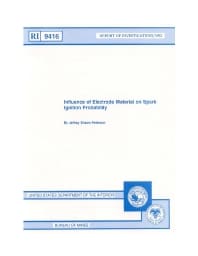Mining Publication: Influence of Electrode Material on Spark Ignition Probability
Original creation date: January 1992
Authors: JS Peterson
NIOSHTIC2 Number: 10011241
U.S. Department of the Interior, Bureau of Mines, Report of Investigations 9416, 1992 Jan:1-19
The testing procedures of the U.S. Mine Safety and Health Administration specify that intrinsic safety acceptance tests be conducted using a standard tungsten-cadmium electrode configuration in the breakflash apparatus. However, in realistic mining environments, other materials may be more likely sources of sparking. Information defining the probability of spark ignition between common materials such as aluminum, brass, copper, lead, tin, cold-rolled steel, and stainless steel is of more practical value in determining ignition hazards. The U.S. Bureau of Mines has completed an investigation of the influence of material on the ignition probability using the breakflash apparatus. By comparing ignition currents or ignition voltages corresponding to a probability of one ignition per thousand sparks to those found previously for cadmium, a margin of safety may be estimated for each material. This report presents the results of an investigation into the influence of disk electrode material on the probability of ignition.

NIOSHTIC2 Number: 10011241
U.S. Department of the Interior, Bureau of Mines, Report of Investigations 9416, 1992 Jan:1-19